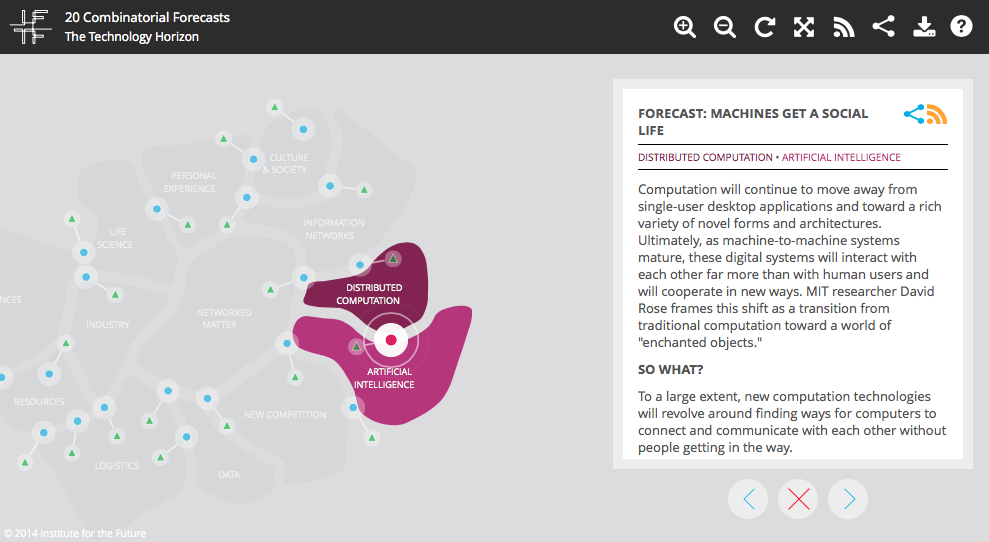Future Now
The IFTF Blog
From #20forecasts: "Machines get a social life"
In 1999, then Procter & Gamble assistant brand manager (and now famous MIT technologist) Kevin Ashton pointed out that computers – and therefore the Internet – were almost wholly dependent on input from human beings for information. At the time, the mere 50 petabytes of data that existed on the web had been nearly entirely created by humans – through the stroking of keyboards, recording of sounds, scanning of bar codes…
Today, over 2.5 exabytes (more than 2560 petabytes) of data is created every day. In a mere 15 years, the world has gone from a place dominated by the input of information by humans, to a world where computers and the machines around us capture, store, and share more than we can imagine.
With the exponential improvement in core technologies – including computation, bandwidth capacity, and digital storage – the movement of conducting computation away from the single-user desktop, and towards a diverse and nuanced array of mobile devices and architectures is advancing at a blinding pace.
What Ashton deemed the ‘Internet of Things’ has come to dominate conversation and investment portfolios in the tech community. With Google’s recent acquisition of Nest for $3.2 B, companies as wide ranging as Quirky and Jawbone closing investment rounds of over $100 M, this movement has only just begun.
Let’s take a deeper dive into the social lives of machines by exploring 3 big ideas developing in the “Internet of Things” space.
-
Smart Everything - From the home to the car to the rainforest, computers and sensors are being embedded in everything – even the human body. With our ever-growing ability to track, analyze, monitor, and report everything around us – from estimating our energy consumption to tracking our heart rate, blood pressure, and respiration – the devices around us are not only smart, they’re becoming aware. As applications and device capabilities continue to advance, ambient intelligence, or AmI as it is called, will become not only a feature of sparse mobile applications scattered here and there, but a defining characteristic of the physical environment surrounding us.
-
Minority Report Realized - In late 2013, it was reported that Tesco would introduce the OptimEyes computer-vision advertising screen to target ads to customers based off their perceived demographics in all 450 of its UK gas stations locations. Not long after, it was reported that Facebook and Walmart were planning to use facial recognition scans to make tailored sales pitches to shoppers, and would likely play a major role in writing legislation regulating such advances.
Estimated to have a market cap of $6.5 B, the facial recognition industry has crossed the threshold of an idea once only held in the minds of sci-fi authors, toward mainstream commercialization. As computer-vision cameras track the facial expressions of consumers in real time, analyzing that data against public profiles on Facebook and LinkedIn, not only will it be possible for machines to identify who a person is, but what profession and economic demographic they fit into, what preferences for clothes or perfume they may have, perhaps even what items they’ve recently searched for online are.
-
The Panopticon Rises– With the revelations of the National Security Agency’s mass surveillance program, PRISM, by Edward Snowden in June 2013, the world got a small glimpse into the vast universe of state-sponsored espionage. As leak after leak has come out, the world has learned that security agencies are engaging in activities ranging from posing as Facebook to infect computers with malware, to actively tracking behavior on social gaming apps like Angry Birds and Candy Crush. As much as we may not want to admit it, and despite the best efforts of companies like Google to thwart the NSA’s practices, surveillance is not going away. In a world where the market for zero-day vulnerabilities and cyber-crime tools is estimated to be in the billions of dollars, it is no longer only nation-states we must be concerned about, but illicit cyber-criminal networks, drug cartels, and private enterprises. While the United States government tries desperately to create a monopsony in the market for software vulnerabilities, the panopticon is rising – perhaps even outside of its own control.
As our devices become more and more connected, collecting and sharing data at an ever-growing pace, it’s hard not to imagine the dystopian possibilities the future may hold. While mass surveillance may make the job of law enforcement more efficient, the equal growth in software vulnerabilities and transnational cyber-criminal networks should bring the most hardened security experts to pause. Already, massive breaches in credit card databases have put major retailers in the spotlight for not securing vital information of consumers. Critical uncertainties surrounding the strength and quality of encryption and database security mean that as our machines become more and more ‘social’ – or intercommunicative - so well may our critical information become more and more insecure. As machines scrape everything from facial recognition scans to consumer preferences to our heart rate and blood pressure, it’s important to consider the consequences of a world that knows our every move. Building systems and protocols to ensure the security of our information will become a critical issue for those interested in ensuring that the social life of machines does not debase the fabric of the world in which we currently live.
This post is the 6th in a series exploring IFTF's new interactive map from our Technology Horizons program, 20 Combinatorial Forecasts—featured in FastCompany Co.EXIST's "When Technologies Combine, Amazing Innovation Happens." Every few weeks we'll take a deep dive into another of the map's twenty forecasts on the future of technology at the intersections of different fields.
Curious about the Technology Horizons program?
- Follow the forecasts at @iftf and #20forecasts
- Find out more about the program
- Check out previous years' Technology Horizons research
- Contact Sean Ness (sness@iftf.org)




